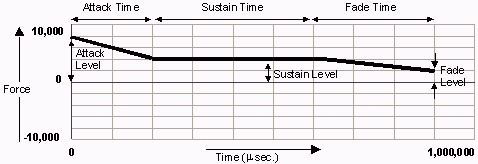A Constant force is a steady force pushing you in a single direction.
One may use a Constant force to simulate a wind, from the Northeast, pushing a sailboat Southwest. Another use would be to simulate a hockey puck being hit from the left. In this example one would feel the Constant force pushing the puck to the right.
Steering wheels, joysticks and a full force feedback mouse can simulate Constant forces. A tactile feedback mouse cannot.
Direction
The direction tells you where the force comes from; the location of the origin of the force. For instance, if you have a Northeast wind it comes from the northeast and pushes the sailboat southwest. The force is located northeast. If you hit a hockey puck from the left, the force comes from the left and moves the ball to the right. The direction, or source of force is located on the left. The direction can be specified in Cartesian coordinates or Polar Coordinates.
Cartesian coordinates are laid out in the following manner: The X-axis runs in the positive direction towards the right, and in a negative direction to the left. The Y-axis runs in the positive direction downwards and in a negative direction upwards. The Cartesian axes and their positive and negative directions correspond to screen coordinates. The increments are in pixels.
To determine what the direction of a force is in Cartesian coordinates you may do the following. Assume the device is located at the origin , coordinates (0,0), where the two axes meet.. Determine where the force will be coming from. Draw a line from that location to the origin. Choose any point along that line and determine its x-y coordinates. These will be the coordinates used to determine the direction. Note that any point on the line will do, as distance from the origin does not matter in determining direction.
To find the coordinates of the northeast wind draw a line as shown below. Pick any point on that line and determine the coordinates. In this case we pick the point at (1, -1).
Polar Coordinates are specified by angles in hundredth of degrees going clockwise away from the negative Y-axis (which represents zero degrees).
To determine the polar coordinates of a force's direction do the following. Assume the device is located at the origin where the two axes meet. Determine where the force originates. Draw a line from that location to the origin. Determine the angle between the negative y axis and the line drawn.
The Northeast wind would have a direction of 45 degrees in polar coordinates.
Duration
Duration specifies the amount of time the effect lasts in milliseconds. It can range from any finite value greater than 0 to infinity.
Envelope
An Envelope is used to describe how a force starts, how it is sustained and how it ends. It shapes the force over time. If we wanted to describe the envelope simulating hitting a hockey puck we would say the force initially is very strong in the beginning for a very short time when it is struck. Then it has a Constant force at a lesser magnitude for another period of time while it coasts along the ice. Finally it slowly loses strength as it comes to a halt. The attack is how the force starts and the fade is how the force ends. You can set the attack level, attack duration, fade level and fade duration. The force will start out at the attack level and then either reduce or increase to the magnitude of the force in the amount of time specified by the attack duration. After sustaining the force at the magnitude and for the duration specified (less the amount of time for attack and fade durations), the force will reduce or increase to the fade level in the amount of time specified by the fade duration. In the case of the hockey puck we could set the attack level to 10000 for 10 milliseconds, set the magnitude of the sustaining force to 7000 for 30 milliseconds and then have it fade out to a magnitude of 0 over 50 milliseconds. If an effect has an infinite duration, no fade level or fade duration should be set.

Gain
Gain is a factor with which you can scale the entire envelope of the effect. It ranges from 0 to 10000, where a gain of 10000 is equivalent to multiplying the forces throughout the effect by a factor of 1, and does not change the size of the envelope at all. A Gain of 5000 would cut all the forces throughout the effect in half. Gain and magnitude are different in that the gain changes the entire size of the envelope whereas the magnitude only changes the strength of the sustained force.
Magnitude
Magnitude specifies the strength of the force. The values can range from -10000 to 10000. A negative value causes the force to come from the direction opposite to the direction specified. A -10000 magnitude for a Constant force with a direction coming from the north direction would behave as if it were coming from the south.
<<
Back to your previous page
Immersion Support Index